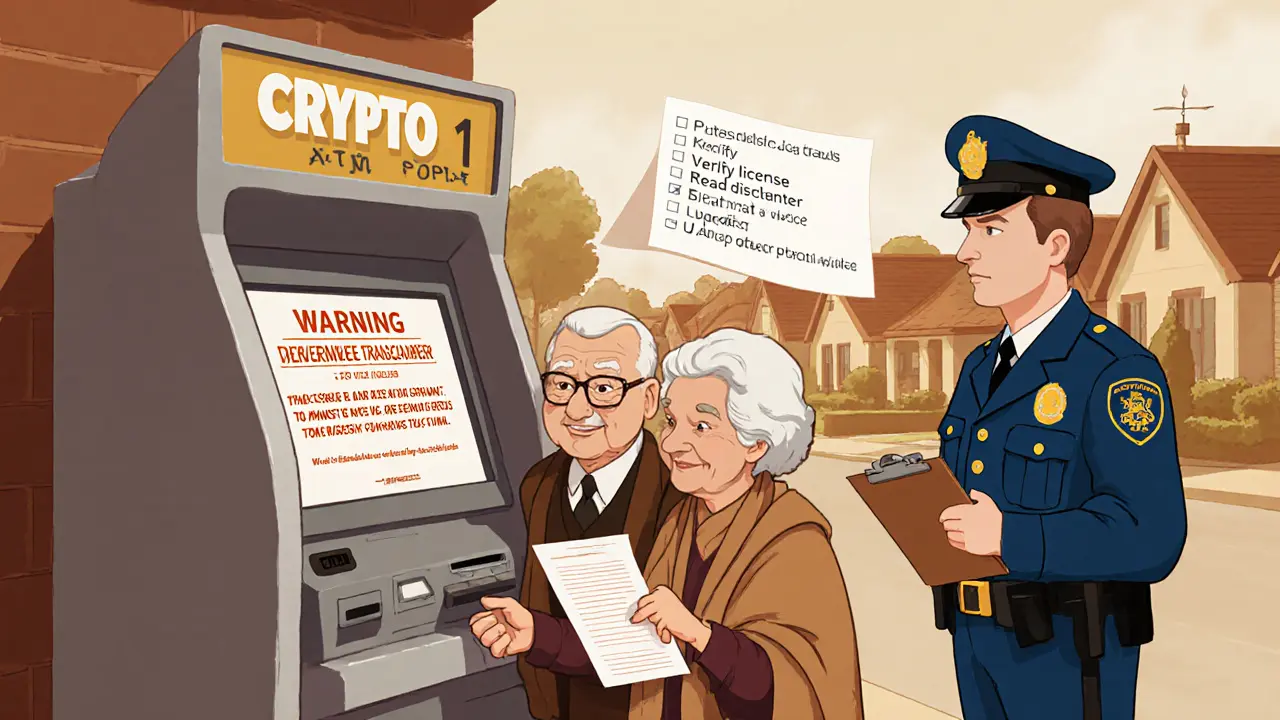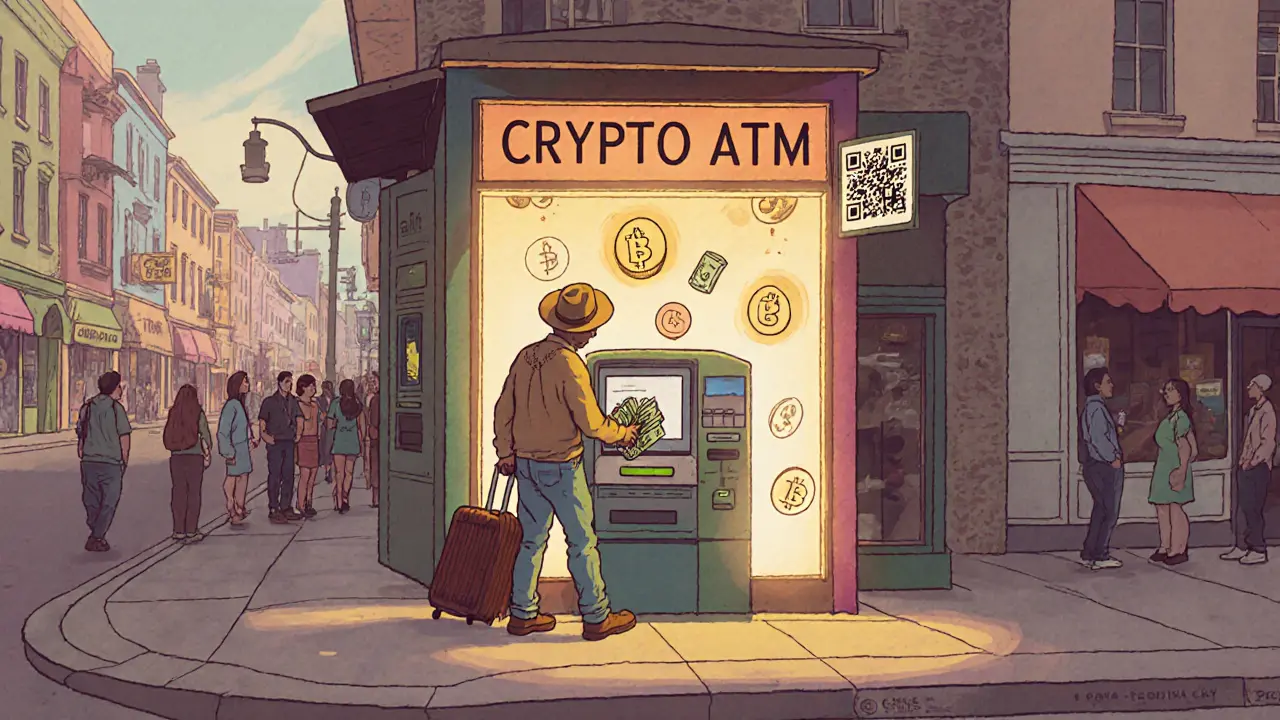Crypto ATM Vulnerability Checker
Check Your Crypto ATM Model
Enter your crypto ATM model name to see if it's vulnerable to known security flaws like CVE-2024-0674
Results
When you walk up to a Crypto ATM is a kiosk that swaps cash for digital coins like Bitcoin and instantly does the reverse. These machines promise quick, anonymous access to crypto assets, but that convenience has turned them into a hotbed for fraud. In 2024 the FBI’s Internet Crime Complaint Center (IC3) logged 10,956 complaints tied to crypto ATMs, totalling $246.7 million in victim losses. The numbers aren’t abstract - seniors, travelers, and everyday investors are watching hard‑earned money disappear with a single screen tap.
Why the numbers matter
The $246 million figure is more than a headline; it signals a systemic failure. FinCEN the Financial Crimes Enforcement Network, published Notice FIN‑2025‑NTC1 on August 4 2025, explicitly warning banks and money‑services businesses about the growing risk posed by crypto kiosks. The notice stresses that most operators ignore core Bank Secrecy Act (BSA) duties - customer identification, transaction monitoring, and suspicious‑activity reporting. Without those safeguards, scammers can walk away with cash, and victims have little recourse because crypto transfers are irreversible.
Technical flaws that open the door
Security researchers have identified concrete software bugs that make crypto ATMs attractive to hackers. Lamassu Douro a popular Bitcoin ATM model from Lamassu Industries AG, was found to contain three critical CVEs (2024‑0674, 2024‑0675, 2024‑0676). The most severe, CVE‑2024‑0674, lets anyone drop a malicious JavaScript file into /tmp/extract/package/updatescript.js and gain root access during the device’s update routine. Once an attacker controls the OS, they can inject wallet‑stealing software, change transaction limits, or completely shut down the kiosk.
These bugs aren’t just academic; they’re the backbone of real‑world scams. Fraudsters plant rogue firmware via the update channel, then watch users insert cash, only to see the crypto sent to an address they control. The victim sees a receipt, but the transaction is already compromised.
Regulatory blind spots vs. traditional ATMs
Traditional banking ATMs sit under a dense web of federal oversight: they must follow the BSA, are subject to periodic audits, and carry multiple layers of fraud detection (e.g., card‑present verification, transaction limits, and real‑time monitoring). Crypto ATMs, by contrast, operate in a gray zone.
| Feature | Crypto ATM | Traditional ATM |
|---|---|---|
| Customer ID (KYC) | Often optional or weak | Mandatory, verified via bank account |
| Transaction monitoring | Rarely implemented | Real‑time monitoring, AML alerts |
| Suspicious‑activity reporting | Usually absent | Required under BSA |
| Refund mechanisms | Minimal; operators often refuse refunds | Standard dispute resolution |
| Regulatory body | FinCEN advisory only | Federal Reserve, OCC, FDIC |

State‑level pushback: Arizona’s new law
Arizona has become a testing ground for stricter oversight. The Arizona Cryptocurrency Kiosk License Fraud Prevention law limits daily transaction amounts to $2,000 for new users and $10,500 for existing ones, forces on‑screen warnings, and requires operators to refund fees and principal if fraud is reported within 30 days. The law also mandates that kiosks keep detailed receipts and share them with law‑enforcement when requested.
Early data show a modest dip in complaints, but the law’s enforcement teeth remain soft. Many operators are small businesses without dedicated compliance staff, so the onus still falls on consumers to stay vigilant.
Who’s getting ripped off?
Senior citizens are disproportionately targeted. FBI data reveal that more than two‑thirds of crypto‑ATM fraud victims in 2024 were over 60, a 99 % jump from the previous year. In Arizona alone, residents lost $177 million, with Scottsdale police reporting $5 million in losses for just one city this year. The demographic pattern reflects two factors:
- Older adults often have savings they’re eager to diversify.
- They may be less familiar with the irreversible nature of blockchain transactions.
AARP the Advocacy group for seniors, surveyed legislators across 11 states and found bipartisan support for tighter crypto‑ATM rules.

Practical steps to avoid a scam
- Verify the kiosk’s operator. Look for a visible license number or QR code that links to the state’s registry.
- Read the on‑screen disclaimer carefully. Reputable machines will warn you that crypto transfers cannot be reversed.
- Never hand over a private key or seed phrase. Legitimate ATMs never ask for this information.
- Use a hardware wallet to receive funds. If the machine pushes you to a web‑based wallet, walk away.
- Check recent news for known vulnerabilities. If the model you’re using is listed in the CVE‑2024‑0674 advisory, consider a different provider.
- Keep a paper receipt and contact the operator within 30 days if anything looks off.
Experts like James Wyler President of Trusted Security Solutions, argue that quantum‑computing threats could someday weaken current encryption, making vigilant vendor selection even more critical. Meanwhile, Nancy LeaMond AARP’s executive vice president, stresses the need for clear, bipartisan legislation that protects consumers without stifling innovation.
Future outlook: Balancing access and safety
FinCEN’s 2025 notice added red‑flag indicators - such as unusually high transaction amounts from a single kiosk - to help financial institutions flag suspicious activity. The broader industry is also moving toward stronger encryption standards (TR‑31) for ATM key management, though those rules apply to all ATMs, not just crypto‑focused ones.
Long‑term, the crypto‑ATM model may need a redesign. Some proposals include:
- Built‑in KYC that verifies identity via biometric scanners.
- Mandatory escrow services that hold crypto for a short period before release, allowing users to cancel if they suspect fraud.
- Standardized firmware updates signed by a trusted authority to close CVE‑like gaps.
If regulators, manufacturers, and consumer‑advocacy groups can align around these upgrades, the $246 million loss figure could become a cautionary footnote rather than a recurring headline.
Bottom line
Crypto ATMs deliver speed and anonymity, but those benefits come with a price tag measured in millions of dollars and countless elderly lives disrupted. Understanding the technical vulnerabilities, the regulatory blind spots, and the simple steps you can take dramatically lowers the odds of becoming a victim. Stay alert, verify operators, and never assume a transaction is reversible.
What makes crypto ATMs attractive to scammers?
They combine cash‑in, instant crypto conversion, and a lack of mandatory KYC, meaning fraudsters can move money quickly and anonymously.
Are all crypto ATMs vulnerable to the same bugs?
Not all, but many share similar Linux‑based firmware. The Lamassu Douro model’s CVE‑2024‑0674 is a notable example; newer models may still inherit the same update‑process flaw.
How does Arizona’s law protect users?
It caps daily transaction amounts, forces clear on‑screen warnings, and requires operators to refund fees and principal if fraud is reported within 30 days.
Can I get my money back after a scam?
Recovery is rare because crypto transfers are irreversible. Some states, like Arizona, mandate refunds if users report fraud quickly, but most operators have no obligation.
What simple steps can I take before using a crypto ATM?
Check the operator’s license, read the disclaimer, use a hardware wallet for receipt, and never share your private key.


Rampraveen Rani
October 26, 2025 AT 09:24🚀 Don't let the hype blind you-always scan the kiosk’s license QR before you feed cash. Look for a visible regulator badge, and if it’s missing, walk away. Quick tip: keep a photo of the receipt on your phone, it helps if you need to dispute later 😎
Dimitri Breiner
November 5, 2025 AT 05:30Totally agree with the point on KYC. Even a minimal ID check can stop a lot of fraud because it ties the cash to a real person. Operators who skip that step are basically handing money to thieves. Keep pressure on local regulators to enforce those basics.
Karla Alcantara
November 15, 2025 AT 01:37I’ve seen seniors get confused by the “no refunds” disclaimer and end up losing savings. A gentle reminder to always read the fine print can save a lot of heartache. If you’re unsure, ask a family member or a friend to double‑check the transaction details.